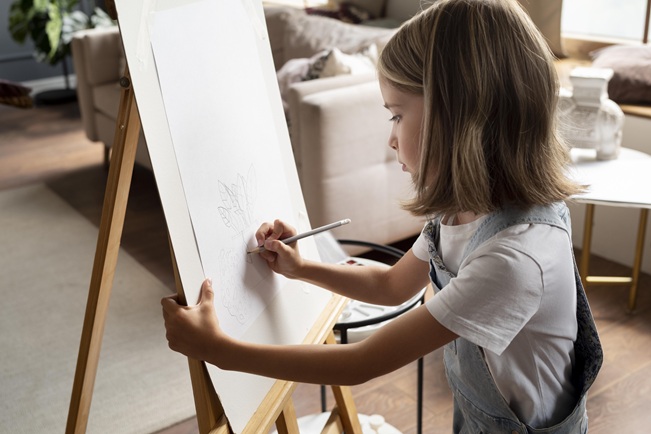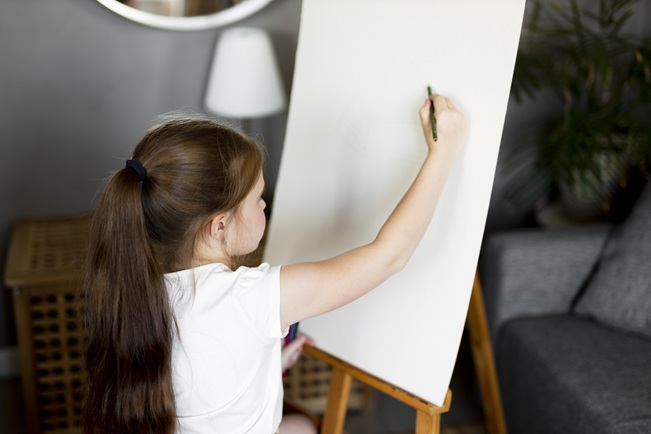There’s something magical about watching a child with a blank surface and a handful of colours. Walls, doors, the fridge… almost anything can become a canvas for them.
That’s why kids need a space of their own, where creativity can spill out safely, and learning sneaks in when no one’s looking. Far from being “just an art stand,” an easel is a gateway to confidence, imagination, and even a touch of independence.
What Exactly is a Kids Easel?

An easel is essentially a sturdy frame that holds a drawing or writing surface upright, but it’s far more flexible than that sounds. Some have chalkboards on one side and whiteboards on the other, perfect for doodles that can be wiped away in seconds. Others include paper rolls for more permanent masterpieces.
You’ll also find clever foldaway designs that tuck neatly into corners, as well as painting easels for kids built to withstand splatters, drips, and enthusiastic brushstrokes.
The point isn’t just to contain the chaos (though that’s a lovely bonus for parents). It’s to give children a dedicated spot where creativity feels natural. When a child approaches their easel, they instinctively know it’s time to create something.
Right now, kids easels come in many shapes. Some are sturdy wooden frames, the kind that could almost pass for miniature furniture. Others are lightweight and foldable, perfect for smaller homes or classrooms.
A classic design might feature a chalkboard on one side and a whiteboard on the other, while more advanced models add a paper roll for paintings. And then, of course, some offer sturdier builds with trays for brushes and pots, designed to handle the joyful chaos of splattered paint.
But beyond the variety, the essence remains the same: a child approaches an easel with anticipation. It’s a signal that something fun is about to happen, that this is their moment to create without limits.
The Hidden Benefits
It’s easy to notice the drawings and scribbles, but what’s happening behind the scenes is even more exciting. Easels don’t just keep the crayons off your walls; they gently shape how children learn, move, and even feel.
Children are naturally curious, and a chalkboard easel makes learning feel less like a chore and more like a game. When they practise writing letters or solving sums in chalk, they’re reinforcing vital skills without the pressure of a workbook. They can erase, start over, and experiment freely. For many, it’s the difference between “ugh, homework” and “look what I can do!”
The upright design also helps children focus. It feels distinct from scribbling at a table, almost like stepping up to a personal blackboard. That sense of occasion encourages them to take ownership of what they’re creating, whether it’s a doodle of the family dog or their first attempts at spelling their name.
Holding markers, gripping paintbrushes, or manipulating magnets on a board all contribute to fine motor control, which is the foundation for good handwriting later on. At the same time, standing at an easel engages larger muscles. Children stretch, step, and move around as they work, building coordination and balance.
There’s also a cognitive workout happening. Planning a picture, deciding which colour goes where, or choosing when a drawing feels “finished” are all exercises in problem-solving and decision-making. To an adult, it may look like playful doodling, but to the child, it’s a rehearsal for the bigger decisions they’ll face as they grow.
An easel offers something children desperately need but often struggle to find: a safe outlet for emotions. The act of drawing or painting can be deeply soothing. After a tiring day, the swish of a brush or the scratch of chalk can melt away frustrations in a way screens simply can’t.
Confidence blossoms too. Every time a child completes a drawing, they’ve created something uniquely their own. Showcasing it, whether on the fridge, the bedroom wall, or the easel its
Choosing the Right One

The best choice depends on your child’s age, personality, and your space at home. Younger children may benefit from a compact, sturdy model that won’t wobble under pressure, while older kids might appreciate a taller easel with shelves for storing paints and pens.
Materials matter too: wood often lasts longer, while lightweight plastic is easy to move around. And if storage is tight, a foldable design is a lifesaver.
The trick is to think of it not just as a purchase, but as an investment in your child’s growth. The right easel will grow with them, adapting from early scribbles to detailed drawings, from alphabet practice to imaginative projects.
Conclusion
When we look past the crayons and chalk dust, it’s clear that kids’ easels are far from simple toys. They’re spaces where children discover what they can do, where learning feels like play, and where creativity doesn’t need permission. They hold the mess, yes, but more importantly, they hold the potential for expression, growth, and joy.
























